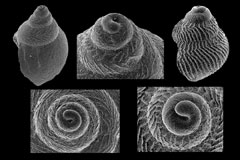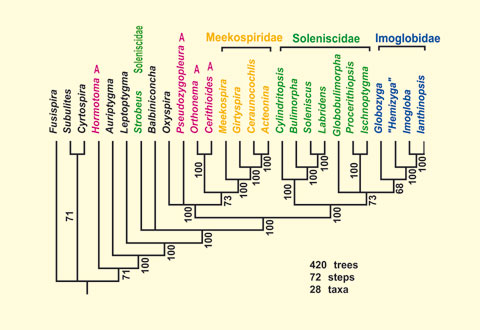Evolution of the Late Palaeozoic Caenogastropoda
Section Fossil Molluscs
The subclass Caenogastropoda is the most diverse group of the Recent Gastropoda. The first undoubted caenogastropods are from the Late Palaeozoic. Caenogastropods can have planktotrophic larval development and larval shells are commonly ornamented in a characteristic way. Therefore, protoconch morphology can be very informative in terms of systematics and larval ecology. Protoconch preservation is very rare in the Palaeozoic. However, in some faunas of the U.S.A. and Australia such well-preserved material is available.
This increases the number of shell characters and therefore the significance of phylogenetic analyses. Phylogenetic, systematic, and taxonomic work has been carried out in DFG-funded projects (especially NU 96/3-1, 3-2) and is still ongoing. The most important Late Paleozoic caenogastropod groups that have been studied are the Subulitoidea, The Zygopleuroidea (especially Pseudozygopleuridae), and the Cerithioidea (e.g., Goniasmatidae and Orthonematidae). These studies allow also a substantial comparison with Mesozoic groups which helps to understand the end-Permian extinction event better. I also try to clarify the early evolutionary history and roots of the major extant caenogastropod clades.
Contact: Prof. Dr. Alexander Nützel

Carboniferous (Mississippian) subulitoid gastropods of the family Imoglobidae Nützel, Erwin & Mapes 2000.
All specimens smaller one 1 mm. These bulbous caenogastropods are characterized by a particular fine larval shell ornament.
Phylogenetic Tree (PAUP) of Late Paleozoic Subulitoidea (modified from Nützel et al. 2000).
Cooperations
Douglas H. Erwin, Dept. of Paleobiology, Museum of Natural History, Smithsonian Institution, Washington D.C., U.S.A.
Jiri Frýda, Czech Geological, Prag, Czech Republic
http://nts1.cgu.cz/portal/page/portal/shared/j/jiri.fryda
Winston F. Ponder, Australian Museum of Natural History, Australia
Pan Hua-zhang, Nanjing Institute of Geology and Palaeontology, Academia Sinica, Nanjing, People’s Republic of China
Royal, H. Mapes, Department of Geological Sciences, Ohio University, Athens 45701, U.S.A.
Alex Cook, Queensland Museum, Brisbane, Australia
Publications
Ponder, W. F., Colgan, D. J., Healy, J. M., Nützel, A., Simone, L. R. L. & Strong, E. E. 2008. Caenogastropoda. In Ponder, W. F. and Lindberg, D. L. (eds), Phylogeny and evolution of the Mollusca. University of California Press (Berkeley, Los Angeles, London): 331-383.
Frýda, J., Nützel, A. & Wagner, P. 2008. Paleozoic Gastropoda. In Ponder, W. and Lindberg, D. L. (eds) In Ponder, W. and Lindberg, D. L. (eds), Phylogeny and evolution of the Mollusca. University of California Press (Berkeley, Los Angeles, London): 239-270.
Cook, A., Nützel, A. & Frýda, J. 2008. Two Carboniferous caenogastropod limpets from Australia and their meaning for the ancestry of the Caenogastropoda. Journal of Paleontology 82: 183-187.
Nützel, A. & Pan Hua-zhang 2005. Late Paleozoic evolution of the Caenogastropoda: larval shell morphology and implications for the Permian/Triassic mass extinction event. Journal of Paleontology 79: 1175-1188.
Bandel, K., Nützel, A. & Yancey, T. E. 2002. Larval shells and shell microstructures of exceptionally well-preserved Late Carboniferous gastropods from the Buckhorn Asphalt deposit (Oklahoma, USA). Senckenbergiana letheae 82: 639-689.
Nützel, A. and Cook, A. G. 2002. Chlorozyga, a new caenogastropod genus from the Early Carboniferous of Australia. – Alcheringa 26:151-157.
Nützel, A., Erwin, D. H. & Mapes, R. H. 2000. Identity and Phylogeny of the Late Paleozoic Subulitoidea (Gastropoda). Journal of Paleontology 74: 575-598.
Nützel, A. & Bandel, K. 2000. Goniasmidae and Orthonemidae: two new families of Palaeozoic Caenogastropoda. Neues Jahrbuch für Geologie und Paläontologie, Monatshefte 9: 557-569.
Nützel, A. 1998. Über die Stammesgeschichte der Ptenoglossa (Gastropoda). Berliner Geowissenschaftliche Abhandlungen, Reihe E 26: 1-229, 35 Tafeln.

